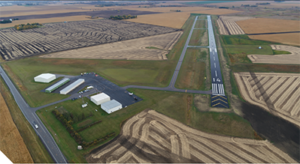Minnesota’s Municipal Airports – Assets for Economic Growth
By Dillon Petrowitz

Minnesota’s extensive network of 133 public airports serves the needs of its residents and visitors and enables significant economic activity across the state.
Of the 133 public airports, seven of those are operated by the Metropolitan Airports Commission (MAC). The other 126 are owned and operated by cities, counties, and/or standalone airport authorities. These airports provide access to Greater Minnesota communities for recreational, business, emergency medical transport, and other needs.
A look at the economic impacts
Minnesota Department of Transportation (MnDOT) Office of Aeronautics conducted a study in 2019 to estimate the annual economic impact of the 126 non-MAC airports. The study identifies annual economic impact as it is related to activities associated with airport management, business tenants, capital investment, and spending by visitors who arrive on general aviation flights and commercial airline flights.
Airport management encompasses full time, part time, or seasonal employment activities associated with managing or operating Minnesota’s airports. In total, 388 employees are responsible for airport management and contribute over $58 million in annual economic activity.
Business tenants provide aviation-related services at airports that include flight instruction, corporate flight departments, aerial applicators, air ambulance, air cargo, airlines, Transportation Security Administration, and terminal concessionaires at eight commercial airports in Greater Minnesota. Total employment for business tenants is more than 9,000, with over $1.1 billion in annual economic activity.
Capital investment relates to the time and money spent to maintain, rehabilitate, and expand airports. Airports implement capital improvement plans with dollars earmarked for improvements for a set planning period. There are 843 employees tied directly or indirectly to capital investment at airports. Over $121 million in annual economic activity is the result of capital investment at the 126 Minnesota airports studied.
Visitor spending economic impacts are those associated with both leisure and business-related travel needs. These typically include expenses such as lodging, meals, ground transportation, retail, and entertainment. The study concluded that almost 80,000 general aviation aircraft bring an estimated 240,000 visitors to the 126 study airports.
Additionally, study surveys show that the average visitor spends between $50 to $270 per trip. General aviation visitor spending economic impacts are directly and indirectly connected to 1,366 employees and over $100 million in annual economic activity. Commercial visitor spending economic impacts at eight commercial study airports were higher than general aviation, with 1,438 employees and over $164 million in annual economic activity.
Morris Municipal Airport: A local economic driver
The City of Morris views its municipal airport as a major asset to the local economy.
One of the city’s largest employers, Superior Industries, relies on the local airport to meet the needs of its engineering and manufacturing of bulk material handling equipment. When Superior Industries and other local businesses expressed the need to make improvements to the Morris Municipal Airport, the community and airport management understood how vital the airport is to maintaining a healthy local economy.
The airport underwent a rigorous planning effort to document existing users and their current operations (landings and takeoffs), and ultimately determined there was a need to extend the primary runway. This allowed for corporate flight departments like that at Superior to continue using the Morris Municipal Airport and not have to relocate to another community with a larger airport. Today, business users of the airport like Superior are continuing to see their businesses flourish as they serve their other locations across the country and outside the United States.
Results from the 2019 Statewide Airport Economic Impact Study show that the Morris Municipal Airport’s local economic activity is almost $2.2 million. This consists of almost $1.6 million in spending and more than $622,000 in payroll.
The airport sees more than 400 visitors annually and is responsible for 16 full-time jobs related to airport activity. Businesses located in Morris, like Superior Industries, routinely use the airport for business and commerce activities. In addition, the airport serves the need for agricultural spray operations and medical support for air ambulance operators like Life Link.
Morris Municipal Airport is an example of one of Minnesota’s 126 non-MAC airports that are critical to our local and state economies, contributing almost $18.2 billion annually. Furthermore, combined annual sales tax and state income tax revenues from the study airports are estimated at $66.3 million. The complete 2019 Minnesota Statewide Airport Economic Impact Study technical report can be found online on the MnDOT Aeronautics site at bit.ly/airportstudy. Individual airport reports and legislative reports (by legislative district) are also available for download.
Dillon Petrowitz is an aviation planner with TKDA (tkda.com/our_work/aviation). TKDA is a member of the League’s Business Leadership Council (lmc.org/sponsors).

